IoT-Integrated AI Framework Using Genetic Algorithms for Waste Management in Smart Campuses
Authors :
Odai nawafleh and Mehak vasta
Address :
Faculty of information and communication technology, university Teknikal Malaysia Melaka, 76100 Durian Tunggal, Melaka, Malaysia
School of computing, Skyline university college, Sharjah, UAE
Abstract :
Effective waste management is critical in developing smart campuses, prioritising sustainability and operational efficiency. Traditional methods often face inefficiencies such as poorly optimized collection routes, inadequate bin placement, and delayed responses to overflow. These limitations increase operational costs, resource wastage, and environmental concerns. The paper proposes IoTGAWMS, an IoT-integrated AI framework leveraging Genetic Algorithms (GAs) to optimize waste management strategies (WMS) and improve resource utilization in smart campuses. The proposed framework employs IoT sensors deployed in waste bins to monitor fill levels, categorize waste types, and transmit real-time data to a centralized platform. A GA optimises waste collection routes, scheduling, and bin placement by considering dynamic constraints such as waste generation patterns and campus traffic. Reinforcement Learning enhances the framework by adapting to real-time changes and learning from historical data, enabling predictive and responsive decision-making. Experimental results demonstrate a 35% improvement in waste collection efficiency and a 25% reduction in fuel consumption for waste transportation compared to traditional methods. Additionally, the framework achieves over 90% accuracy in waste type classification, significantly enhancing recycling initiatives. In conclusion, the proposed IoTintegrated AI framework effectively overcomes the limitations of traditional methods, providing a sustainable and efficient solution for waste management in smart campuses..
Keywords :
IoT, Waste Management, Smart Campuses, Genetic Algorithms, Reinforcement Learning, Optimization, Real-Time Monitoring
1.Introduction
With the increase in urbanization and population, the existing waste management systems are under strain, and sustainable waste management has become a concern worldwide [1]. Being a miniversion of modern cities, a smart campus should maintain good waste management practices alongside conserving environmental sustainability and face the same challenges. Revolutionary waste management procedures could be developed with state-of-the-art technologies like artificial intelligence (AI) and the Internet of Things (IoT) [2]. While AI optimizes resource allocation, routing, and scheduling, IoT enables real-time monitoring of fill levels of garbage bins, waste categorization, and environmental conditions. These technologies support several global sustainability objectives that encourage recycling, reduce greenhouse gas emissions, and avoid landfill use [3]. Common inefficiencies in traditional waste management systems can be overflows, underutilized resources, and higher operational costs due to manual monitoring and static scheduling [4]. The smart campus should serve as a pilot test bed for the latest frameworks of waste management implementation, given their regulated and digitalized environment. Through the prevalent application of IoT sensors, granular data on trash formation patterns can now be collected. At the same time, predictive and adaptive techniques in management are possible through advances in artificial intelligence—specifically in machine learning and optimization algorithms [5]. By reducing resource wastage and increasing recycling rates, these trends should enhance operational efficiency and contribute to long-term sustainability [6]. IoTB and AI integration have potential, yet it faces many challenges before deployment. To make IoTB deployment smooth and efficient, network dependability, data security, computational complexity, and other concerns must be considered [7]. The interdisciplinary study of IoT, AI, and sustainability sciences is very important in tackling operational and technical challenges in the era of increasing digitalization in waste management [8]. Conventional waste management methods on smart campus premises are mostly ineffective due to inflexible scheduling, shoddy bin placement, and slow reaction times of the overflowing status [9]. These inefficiencies augment the deterioration of the environment, waste of resources, and higher expenses for operations. Such problems are further deteriorated by inefficient solid waste management strategies that do not consider the fluctuation in the patterns of waste generation and traffic conditions due to lacking dynamic and adaptive systems [10].
IoTGAWMS utilizes Internet of Things (IoT) sensors built into trash cans to collect real-time data on garbage type and fill level. The data is transmitted to a central platform where AI algorithms process and analyse it. Genetic algorithms work well with static optimization problems, such as the optimal location of bins or the creation of efficient collection routes. Such algorithms consider constraints like traffic patterns and rates of garbage production. Further enhanced by the Reinforcement Learning in dynamically changing the routes and timetables according to current trends and changes as well as past ones, with its adaptability and scalability, the system could handle varying conditions, showing why it becomes a great fit for any Smart Campus environment.
The main significance of the paper is
- To introduce IoTGAWMS, a hybrid IoT-AI framework combining GA and RL for waste management optimization.
- • To demonstrate real-time adaptability through IoT integration, enabling dynamic response to fill levels and waste generation variability.
- To improve waste collection efficiency by 35% and reduce transportation fuel consumption by 25% compared to traditional methods.
- To achieve over 90% waste classification accuracy, enhancing recycling efforts and promoting environmental sustainability.
The paper is structured as follows: Section 1 introduces the research context, problem, and methodology. Section 2 reviews related work. Section 3 details the proposed framework. Section 4 presents experimental results, and Section 5 concludes with future directions.
2. Related Works
Padhiary, Mrutyunjay, et al. [11] proposed the AI-IoT Urban Connectivity Framework for enhancing sustainability and infrastructure in smart cities. The framework used artificial intelligence for predictive analytics and the Internet of Things for real-time data collection, battling disjointed systems and ineffective city management. The framework improved urban connectedness, resource utilization, and energy efficiency. The framework optimizes smart city operations and supports sustainable urban development since it provides an integral approach to overcome the drawbacks of traditional models related to integration and effective decision-making.
Kothai G. et al. [12] proposed the Smart Waste Management Solution, SWMS, that will change the face of urban garbage management with AI and the Internet of Things. It improved the recycling procedures, reduced reliance on landfills, and optimized waste segregation using real-time Internet of Things (IoT) sensors and analytics powered by artificial intelligence. The results showed that trash processing was more efficient and had a positive impact on the environment. SWMS has come up with a technology-enabled solution to the problems related to modern urban waste management, including fragmentation and the lack of advanced, data-driven integration in older systems. Ming et al. [13] proposed an AI-driven waste management system, AI-WMS, to improve garbage collection, sorting, and recycling operations. It adopted machine-learning algorithms to achieve predictive waste analytics for better efficiency and scalability in operations. Results showed this would increase resource recovery and decrease expenditures, proving the system's effectiveness in addressing large-scale waste management issues. Equipped with state-of-the-art analytics and technology-driven waste management processes, AI-WMS helps to overcome the inefficiencies and scalability issues associated with traditional methods.
Hussian, Iftikhar, et al. [14] proposed the IoT Multiagent Waste Model, IoTMWM, to optimize waste management through IoT-enabled multiagent simulations. It simulated different garbage collection models, which improved resource management and increased trash collection efficiency. The major outcome of the study was better operational accuracy and flexibility. IoTMWM tackles the shortcomings of its predecessors through simulation-based approaches combined with IoT, making it possible to carry out waste management more efficiently and dynamically. Khan, Sangrez, et al. [15] propose IoTCWS, an approach based on route optimization and dynamic scheduling for improving smart city waste collection. It leverages AI algorithms for effective route planning and IoT sensors for gathering real-time waste data, which showed better fuel consumption reduction and increased collection efficiency. Through the newest technology, IoT-WCS improved the traditional way of managing urban waste collection by making it more adaptive in realtime, with better route options.
Parimita Widya et al. [16] introduced an AI-based gamified Waste Ecosystem (AI-GWE) to promote green economic growth using gamification techniques. AI-GWE motivated sustainable waste management practices and recycling through AI-based platforms. The results were amazing, with a huge reduction in trash production coupled with increased user participation. With its successful integration of more user-centric gamification approaches, AI-GWE has tackled urban waste management in ways that support environmental sustainability goals while being more participative and impactful than traditional means. Othman, Salwa et al. [17] introduced the AI-IoTROF Resource Optimization Framework to enhance smart city waste management. Since it ran with machine learning models, the framework made dynamic decisions that could lead to better resource distribution and substantial waste reduction. Results have shown improvement in operational efficiency and sustainability. Artificial intelligence can efficiently revolutionize urban trash management in IoT-enabled areas, as it deals with inefficiencies caused by previous systems' lack of real-time integration and enhanced optimization capabilities. Hossain, Imran, et al. [18], have developed the IoMT-AIWMS for Rajshahi City Corporation. The system integrates IoT sensors with AI and Android-based applications to optimize garbage collection. To maximize efficiency, this method dynamically changed collection schedules and routes. The results showed an increase in waste collection and community participation. The major downfalls of the earlier systems were archaic technology, poor integration, and an absence of real-time data-driven decision-making capabilities. Over those limits in waste management, IoT-AIWMS enhanced effectiveness and flexibility and brought state-of-the-art technology.3. Research Methodology
Dataset: The dataset in "Smart Waste Management System using IoT" [20] is from the data collected by different sensors integrated into smart dustbins. The main components include load sensors for measuring the weight of waste, IR sensors for detecting the presence and movement of trash, and a Wi-Fi module for connectivity. This allows for real-time monitoring of the level of waste to enable efficient garbage collection. It provides system architecture for remote access to each dustbin's status to optimize resource allocation and reduce unrequired trips by garbage collection vehicles. Overall, this dataset helps to maintain good waste management and, hence, a pollution-free environment. IoT Sensor Deployment: IoT sensors are put into waste bins around campus, hence enabling realtime monitoring of fill levels, waste types, and environmental conditions. This data collected is then sent to a centralized platform, allowing continuous monitoring and analysis. The system provides actionable insights to help optimize waste collection and resource allocation and assess environmental impact. Another good example of an innovative smart campus application is integrating IoT technologies into waste management, thus making the campus more efficient and sustainable through data-driven decision-making.
a. The IoTGAWMS Framework
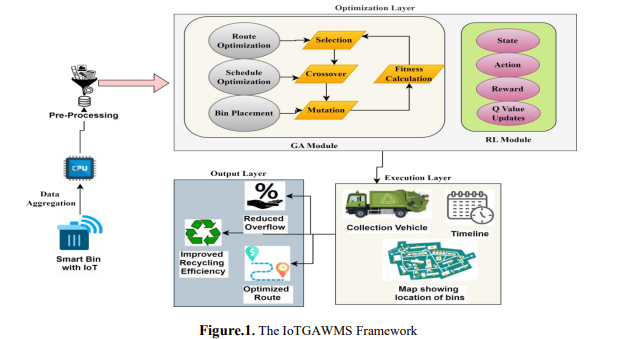
The entire process of the proposed IoT-integrated AI framework, IoTGAWMS, for waste management in a smart campus could be segmented as shown below. Figure 1 presents the process of the IoTGAWMS Framework.
Data Collection and Preprocessing: Real-time sensor data is acquired and processed to classify the waste into organic, recyclable, and non-recyclable types, besides detecting the generation patterns of waste on campus. Analyzing the processed data helps track usage and detects bin overflow events,which could be useful in tracking trends around waste disposal behavior. All this preprocessing ensures that the data is reliable and consistent, forming a basis for making informed decisions in optimizing collection schedules, minimizing inefficiencies, and enhancing overall strategies for managing waste.
b. Genetic Algorithm Optimization in Waste Management:
Genetic Algorithm (GA) is a bio-inspired optimization technique that simulates natural selection to find optimal solutions for complex problems. In waste management, GA optimizes collection routes, scheduling, and bin placement as follows: Inputs to the Genetic Algorithm: Sensor data provides real-time information about the fill levels of the bins, waste types, location coordinates, and overflow patterns. This becomes the basis for optimization. The following parameters of the algorithm are defined: the population size, 𝑃, which determines how many candidate solutions are included in each generation. The number of generations, 𝐺, which specifies how many iterations to evolve, crossover rate, 𝐶𝑟 , controlling how often parent solutions are combined, and mutation rate, 𝑀𝑟 , the probability of introducing variations to explore diverse solutions
Initialization Phase: The initialization phase encodes potential solutions as chromosomes tailored to the problem's subtasks. In the case of routes, chromosomes represent sequences of bin IDs, recording the order in which bins are serviced. In the case of schedules, chromosomes represent time slots assigned to each bin for efficient waste collection timing. For placements, chromosomes are represented as binary vectors, where 1 denotes a bin at a given location and 0 its absence. An initial population of random chromosomes is then generated to ensure that diverse candidate solutions will explore the solution space effectively in subsequent iterations. Fitness Functions: Fitness functions determine the quality of candidate solutions for each objective—routes, schedules, and placements—to drive the Genetic Algorithm (GA) to optimum solutions.
i. Routes (Minimize Total Distance)
The objective is to minimize the total distance driven by waste collection trucks, which is calculated using Equation 1. 𝑓𝑟𝑜𝑢𝑡𝑒 = 1 1+∑ 𝑑𝑖𝑗⋅𝑥𝑖𝑗 𝑁 𝑖=1 (1) where 𝑑𝑖𝑗 is the distance between bin 𝑖 and 𝑗, 𝑥𝑖𝑗 is the binary variable (1 if the path between bin 𝑖 and 𝑗 is included in the route, 0 otherwise) and 𝑁 is the total number of bins. It rewards shorterdistance routes by reducing the summation of distances (𝑑𝑖𝑗) over chosen paths (𝑥𝑖𝑗). Being reciprocal, this function ensures an increase in fitness value with a decrease in travel distance because the denominator decreases.
ii. Schedules (Minimize Overflow Risk)
The goal is to arrange waste collection so that bins are emptied before they overflow. This is obtained from equation 2. 𝑓𝑠𝑐ℎ𝑒𝑑𝑢𝑙𝑒 = 1 1+∑ (𝑇𝑖−𝐹𝑖 ) 𝑁 𝑖=1 2 (2) where 𝑇𝑖 is the scheduled collection time for bin 𝑖. 𝐹𝑖 is the predicted overflow time for bin iii, derived from sensor data trends. 𝑁 is the total number of bins. This function penalizes deviations of the scheduled collection time (𝑇𝑖 ) from the predicted overflow time (𝐹𝑖 ), as represented by the squared difference. The smaller the deviation, the higher the fitness value, ensuring bins are serviced close to their critical thresholds and avoiding premature collection and overflow.
iii. Placements (Maximize Accessibility and Minimize Overflow)
The aim is to find convenient bin locations and minimize the chance of overflowing. This could be achieved by equation 3. 𝑓𝑝𝑙𝑎𝑐𝑒𝑚𝑒𝑛𝑡 = ∑ (𝐴𝑖 − 𝑂𝑖) 𝑁 𝑖=1 (3) where 𝐴𝑖 is the accessibility score of bin location iii, determined by proximity to high-traffic areas or ease of access, 𝑂𝑖 is the overflow risk score of bin location iii, based on historical patterns or environmental factors, and 𝑁 is the total number of candidate bin locations. The fitness function estimates the net benefit of each bin location by subtracting the overflow risk (𝑂𝑖 ) from the accessibility score (𝐴𝑖 ). Locations with a high score are accessible and have low overflow risks, thus ensuring the strategic placement of bins across the campus.
Genetic Operation: Genetic operations are important in evolving solutions toward optimal waste management strategies. • The selection step uses techniques such as roulette wheel or tournament selection in selecting parent chromosomes based on fitness scores, so that fitter solutions are more likely to contribute to the next generation. • Crossover is different for each objective: for routes order crossover (OX) preserves sequence integrity; for schedules, arithmetic crossover blends time slots; and for placements, single-point crossover flips binary vectors. • Mutation introduces diversity in the population: it randomly swaps bin IDs in routes, shifts collection times within valid ranges in schedules, and flips binary values in placements. Elitism helps to retain the best-performing chromosomes within the population, which, in essence, retains the best solutions across generations, balancing exploration and exploitation during optimization. The optimization will stop when predefined conditions are met. First, there must be a maximum number of generations, GGG, so the algorithm does not run forever. Secondly, there mustn't be a significant fitness improvement over some consecutive generations, meaning the algorithm has converged to a near-optimal solution. These criteria balance computational efficiency with solution quality; the process should terminate when further iterations are unlikely to yield substantial gains.
Reinforcement Learning (RL): Reinforcement Learning is a dynamic approach to optimizing waste management through adaptation to real-time changes, including unstable waste generation patterns, traffic conditions, and other environmental factors. In this case, RL treats waste management as a learning problem where an agent—the waste management system—interacts with the environment—campus conditions—to achieve optimal performance. It learns to make predictive decisions through constant analysis of historical and real-time data, such as adjusting collection routes, schedules, or bin placements. RL improves efficiency by dynamically adjusting operations to changed circumstances, reduces waste overflows and travel distances, and optimizes resource utilization. This adaptability ensures that waste management will stay responsive, sustainable, and efficient in the long run. Table 1 shows the Pseudocode for Reinforcement Learning (RL) in Waste Management Optimization.
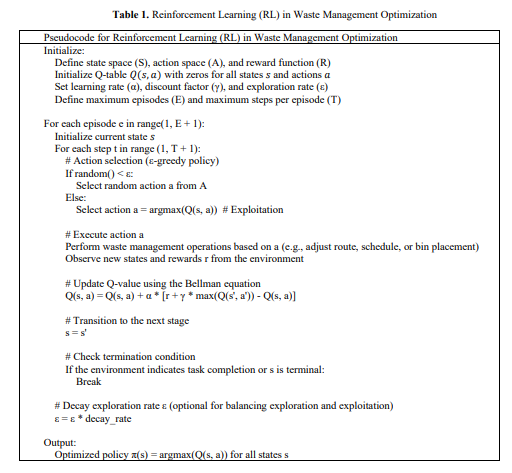
Implementation & Monitoring: It is integrated with campus infrastructure for seamless and continuous monitoring of waste management operations, including collection, transportation, and recycling processes. Real-time sensor data and predictive analytics ensure operational efficiency. The accuracy in classifying waste types is very high, above 90%, allowing targeted recycling while reducing contributions to landfill sites. This enhances operational efficiency and supports the achievement of sustainability goals through better resource recovery and reduced environmental impact.
4. Result and discussion
a.Performance Metrics
This section compares the IoTGAWMS method with SWMS [12], AI-IoTROF [17], and IoTAIWMS [18] based on metrics such as Collection Efficiency, System Efficiency, and Waste Type Classification Accuracy. The analysis highlights the performance differences across these methods, demonstrating IoTGAWMS's advantages in waste management systems. By evaluating these key metrics, the comparison provides insights into the effectiveness of IoTGAWMS over existing approaches, showcasing its potential to improve waste classification and overall operational efficiency. Collection Efficiency: It can be measured in terms of time savings, route optimization, and the use of resources by waste collection trucks. It calculates how well the waste management system reduces the time and resources used for waste collection and can be further expressed in equation 4. 𝐶𝑜𝑙𝑙𝑒𝑐𝑡𝑖𝑜𝑛 𝐸𝑓𝑓𝑖𝑐𝑖𝑒𝑛𝑐𝑦 (𝐶𝐸) = 𝑇𝑖𝑑𝑒𝑎𝑙−𝑇𝑎𝑐𝑡𝑢𝑎𝑙 𝑇𝑖𝑑𝑒𝑎𝑙 (4) where 𝑇𝑖𝑑𝑒𝑎𝑙 is the collection time of wastes by taking the optimal route (ideal scenario without inefficiencies) and 𝑇𝑎𝑐𝑡𝑢𝑎𝑙 is the waste collection time with the implemented system (using optimized routes and operational strategies).
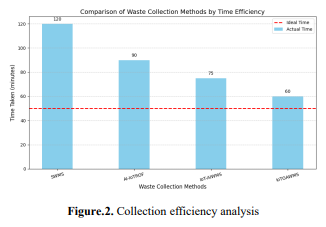
Figure 2 shows the effectiveness of alternative waste collection techniques by plotting their actual time consumed, 𝑇𝑎𝑐𝑡𝑢𝑎𝑙, against a theoretical ideal time, 𝑇𝑖𝑑𝑒𝑎𝑙. The graph shows the comparative analysis of traditional SWMS, AI-IoTROF, IoT-AIWMS, and the proposed IoTGAWMS. In addition, the bar graph highlights important reductions in time taken with optimal methods, in which the proposed IoTGAWMS exhibits a lower collection time. A red dashed line represents 𝑇𝑖𝑑𝑒𝑎𝑙 and serves as a benchmark for comparison. The graph shows the advantage of using advanced optimization techniques, such as IoTGAWMS, in gaining efficiency, reducing time, and approaching the optimal performance for sustainable waste management.
Waste Type Classification Accuracy: It measures how effective a waste management system is at correctly classifying different categories of waste (e.g., organic, recyclable, landfill) based on sensor data, images, or any other features. This is calculated as in equation 5. 𝐴𝑐𝑐𝑢𝑟𝑎𝑐𝑦 = 𝑁𝑢𝑚𝑏𝑒𝑟 𝑜𝑓 𝐶𝑜𝑟𝑟𝑒𝑐𝑡𝑙𝑦 𝐶𝑙𝑎𝑠𝑠𝑖𝑓𝑖𝑒𝑑 𝐼𝑛𝑠𝑡𝑎𝑛𝑐𝑒𝑠 𝑇𝑜𝑡𝑎𝑙 𝑁𝑢𝑚𝑏𝑒𝑟 𝑜𝑓 𝐼𝑛𝑠𝑡𝑎𝑛𝑐𝑒𝑠 × 100 (5) where 𝐶𝑜𝑟𝑟𝑒𝑐𝑡𝑙𝑦 𝐶𝑙𝑎𝑠𝑠𝑖𝑓𝑖𝑒𝑑 𝐼𝑛𝑠𝑡𝑎𝑛𝑐𝑒𝑠 is the quantity of waste articles identified by the system accurately and 𝑇𝑜𝑡𝑎𝑙 𝑁𝑢𝑚𝑏𝑒𝑟 𝑜𝑓 𝐼𝑛𝑠𝑡𝑎𝑛𝑐𝑒𝑠 is the total number of waste items the system tries to classify.
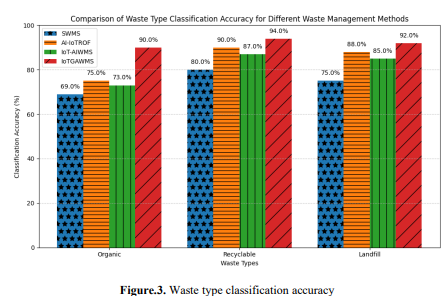
Figure 3 shows the comparative analysis of waste type classification accuracy among four different waste management methods: traditional SWMS, AI-IoTROF, IoT-AIWMS, and the proposed IoTGAWMS. Three waste types—Organic, Recyclable, and Landfill—are represented through bars for each method. The height of each bar denotes the percentage value of classification accuracy, while the labels at the bottom give the exact accuracy values. The chart indicates that the proposed IoTGAWMS is better than other methods, especially in recycling and landfill waste. It is readable with all different patterns and colours, as grid lines have been added to make comparing the method's results clearer.
System Efficiency in waste management describes how effectively a system converts input resources, such as time, energy, or operational costs, into desired outputs, such as waste processed, resources recovered, or waste reduced. Generally, efficiency in waste management compares different means by measuring the amounts of waste managed or resources recovered per unit of input resources, such as time or energy. This is shown in equation 6. 𝑆𝑦𝑠𝑡𝑒𝑚 𝐸𝑓𝑓𝑖𝑐𝑖𝑒𝑛𝑐𝑦 = 𝑂𝑢𝑡𝑝𝑢𝑡 (𝑒.𝑔., 𝑤𝑎𝑠𝑡𝑒 𝑝𝑟𝑜𝑐𝑒𝑠𝑠𝑒𝑑, 𝑟𝑒𝑠𝑜𝑢𝑟𝑐𝑒𝑠 𝑟𝑒𝑐𝑜𝑣𝑒𝑟𝑒𝑑) 𝐼𝑛𝑝𝑢𝑡 (𝑒.𝑔., 𝑡𝑖𝑚𝑒, 𝑒𝑛𝑒𝑟𝑔𝑦, 𝑜𝑝𝑒𝑟𝑎𝑡𝑖𝑜𝑛𝑎𝑙 𝑐𝑜𝑠𝑡) (6) where 𝑂𝑢𝑡𝑝𝑢𝑡 means the amount of waste appropriately treated (kg of waste treated or % recycling rate achieved) and 𝐼𝑛𝑝𝑢𝑡 means total invested resources (for example, time invested in collection, energy invested in transport, or operating expense).
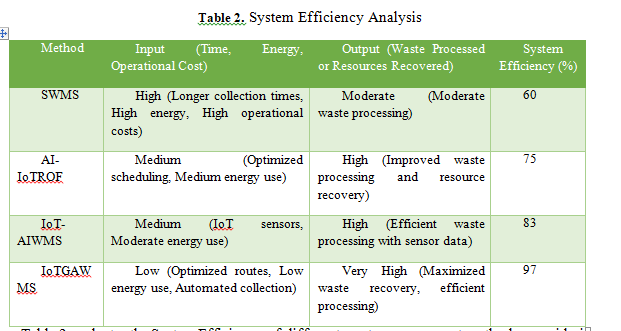
Table 2 evaluates the System Efficiency of different waste management methods, considering various inputs (time, energy, operational costs) and outputs (waste processed or resources recovered). The Traditional SWMS has high inputs with moderate efficiency, as it lacks optimization. AI-IoTROF improves efficiency with medium inputs, leveraging AI and IoT for better waste processing. IoTAIWMS shows further improvement in efficiency due to its use of IoT sensors for real-time data. The Proposed IoTGAWMS outperforms all others with the lowest inputs and the highest output, demonstrating superior efficiency through optimized routes, energy use, and automation in waste collection.
5. Conclusion
The proposed IoT-Integrated AI Framework for Waste Management in Smart Campuses will adopt a holistic and adaptive approach to optimize the waste collection strategy. It will address efficient management of collection routes, scheduling, and bin placement, through leveraging realtime data from IoT sensors by applying Genetic Algorithms (GA) and Reinforcement Learning (RL). Advanced machine learning techniques are integrated to ensure dynamic adaptability in fluctuating waste pattern and environmental conditions, enhancing overall operational efficiency in campus waste management. With more than 90% accuracy in the classification of waste types and great improvement in resource utilization, the system supports sustainable practices by reducing environmental impact and operational costs. Further, because it is easy to integrate into the existing campus infrastructure, implementation and monitoring are effortless and lead to a cleaner and smarter campus environment in the long term. One of the limitations of this framework is its total dependence on the quality and reliability of IoT sensor data, which may be compromised by hardware failure or environmental conditions. This will be addressed in future work focusing on improving fault tolerance through predictive maintenance and exploring the integration of blockchain technology for secure, decentralized waste management systems that assure data integrity and scalability in larger smart cities.
References :
[1]. Bharti, Sharda, Shourat Fatma, and Vinay Kumar. "AI in waste management: the savage of environment." Environmental Informatics: Challenges and Solutions (2022): 97-123.
[2]. Zhang, Yuchen, et al. "A systematic review on technologies and applications in smart campus: A humancentered case study." IEEE Access 10 (2022): 16134-16149.
[3]. Sosunova, Inna, and Jari Porras. "IoT-enabled smart waste management systems for smart cities: A systematic review." IEEE Access 10 (2022): 73326-73363.
[4]. Vishnu, S., et al. "IoT-Enabled solid waste management in smart cities." Smart Cities 4.3 (2021): 1004- 1017.
[5]. . Ghahramani, Mohammadhossein, et al. "IoT-based route recommendation for an intelligent waste management system." IEEE Internet of Things Journal 9.14 (2021): 11883-11892.
[6]. Wang, Cong, et al. "A smart municipal waste management system based on deep-learning and Internet of Things." Waste Management 135 (2021): 20-29.
[7]. Fang, Bingbing, et al. "Artificial intelligence for waste management in smart cities: a review." Environmental Chemistry Letters 21.4 (2023): 1959-1989.
[8].Subeesh, A., & Mehta, C. R. (2021). Automation and digitization of agriculture using artificial intelligence and internet of things. Artificial Intelligence in Agriculture, 5, 278-291.
[9]. Hernandez, Daniel, et al. "The role of artificial intelligence in sustainable agriculture and waste management: Towards a green future." International Transactions on Artificial Intelligence 2.2 (2024): 150-157.
[10]. Yao, Yao, et al. "AI-powered Strategies for Optimizing Waste Management in Smart Cities in Beijing." (2024).
[11]. . Padhiary, Mrutyunjay, Pankaj Roy, and Dipak Roy. "The Future of Urban Connectivity: AI and IoT in Smart Cities." Sustainable Smart Cities and the Future of Urban Development. IGI Global Scientific Publishing, 2025. 33-66.
[12]. . Kothai, G., et al. "Transforming Urban Waste Management: Innovations and Sustainable Solutions for Modern Cities." Sustainable Smart Cities and the Future of Urban Development. IGI Global Scientific Publishing, 2025. 287-314.
[13]. Ming, Li Wei, et al. "Ai as a driver of efficiency in waste management and resource recovery." International Transactions on Artificial Intelligence 2.2 (2024): 128-134.
[14]. Hussain, Iftikhar, et al. "Smart city solutions: Comparative analysis of waste management models in IoTenabled environments using multiagent simulation." Sustainable Cities and Society 103 (2024): 105247
[15]. Khan, Sangrez, et al. "Efficient IoT-Assisted Waste Collection for Urban Smart Cities." Sensors 24.10 (2024): 3167.
[16]. . Singagerda, Faurani Santi, et al. "Towards a Circular Economy: Integration of AI in Waste Management for Sustainable Urban Growth." Journal of Lifestyle and SDGs Review 5.1 (2025): e02642-e02642.
[17]. . Othmen, Salwa, Wahida Mansouri, and Radhia Khdhir. "Applying Artificial Intelligence Techniques For Resource Management in the Internet of Things (IoT)." International Journal of Electrical and Computer Engineering Systems 16.2 (2025): 81-92.
[18].Hossain, Imran, AKM Mahmudul Haque, and SM Akram Ullah. "Assessing sustainable waste management practices in Rajshahi City Corporation: an analysis for local government enhancement using IoT, AI, and Android technology." Environmental Science and Pollution Research (2024): 1-19.
[19]. . Hossain, Imran, AKM Mahmudul Haque, and SM Akram Ullah. "Assessing sustainable waste management practices in Rajshahi City Corporation: an analysis for local government enhancement using IoT, AI, and Android technology." Environmental Science and Pollution Research (2024): 1-19.
[20]. Kadus, Tejashree, Pawankumar Nirmal, and Kartikee Kulkarni. "Smart waste management system using IOT." International Journal of Engineering Research and 9.04 (2020).